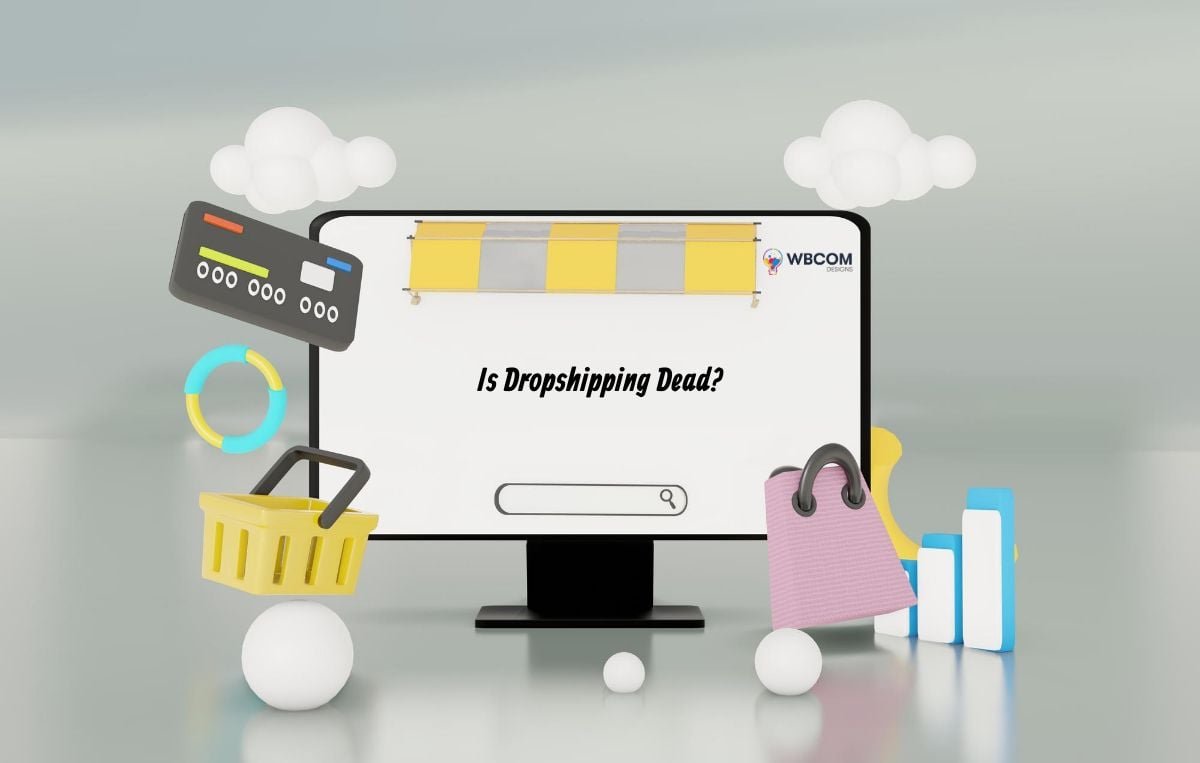In today’s dynamic e-commerce landscape, the question persists: “Is Dropshipping Dead?” Dropshipping, a retail fulfillment method where businesses don’t keep products in stock but instead transfer customer orders and shipment details to third-party suppliers, has faced this ongoing inquiry due to the shifting tides of online commerce. Despite skepticism, dropshipping remains a pivotal approach in the e-commerce realm.
The evolving nature of online shopping, marked by ever-changing consumer preferences and market dynamics, fuels this query. The essence of dropshipping lies not in its demise but in its adaptation to these transformations, illustrating its resilience amidst the constantly evolving e-commerce ecosystem. Understanding this method’s place in the contemporary market demands an exploration of its continued relevance amidst the e-commerce metamorphosis.
Table of Contents
ToggleIs Dropshipping Still Alive: Google Trends For Dropshipping
In the ever-evolving realm of e-commerce, the vitality of dropshipping is a subject of constant scrutiny. Understanding the pulse of this business model requires delving into various metrics, one of which is Google Trends. This tool provides a dynamic visualization of the interest and search volume surrounding dropshipping over a specific period. Examining Google Trends for dropshipping unveils valuable insights into its relevance and the trajectory it might follow shortly. Analyzing this data aids in deciphering the level of public interest and potential market fluctuations impacting the viability of dropshipping as a business model.
Google Trends for Dropshipping:
Google Trends, a versatile and accessible tool, offers a window into the popularity of search queries related to dropshipping. When examining the trends for dropshipping, several key observations emerge:
Interest Fluctuations
Over the past few years, interest fluctuations have often corresponded to specific seasons or global events. Peaks and troughs in the search volume for dropshipping reflect varying levels of public curiosity or engagement.
Geographical Variances
The interest in dropshipping isn’t uniform across regions. Different countries exhibit distinct patterns in their search behavior, indicating varying levels of adoption or exploration of this business model.
Comparison with Related Terms
Analyzing dropshipping compared to related terms such as e-commerce, online retail, or specific platforms like Shopify, provides a contextually rich understanding of its place within the broader e-commerce landscape.
Seasonal Trends
Notably, seasonal trends often influence the search volume for dropshipping, suggesting that certain times of the year witness heightened interest or engagement in this business model.
Current Trajectory
The current trend data indicates a sustained level of interest in dropshipping. While there might be fluctuations, the overall pattern suggests that dropshipping remains a topic of consistent interest among individuals exploring entrepreneurial ventures or seeking alternative income streams.
By leveraging Google Trends, one can gain a nuanced understanding of the public’s interest in dropshipping, allowing for informed predictions and strategies within the dynamic e-commerce space.
Also Read: Breakdance vs Elementor: Which Is Better?
Is Dropshipping Worth it in 2024?
Here are some key points to consider when evaluating the worth of dropshipping in 2024:
Market Dynamics:
- Increased competition within the dropshipping space might require more strategic differentiation.
- Market saturation in certain niches could impact profit margins.
Technological Advancements:
- Integration of AI and automation tools has streamlined processes, potentially reducing operational complexities.
- Enhanced analytics and customer targeting capabilities provide a competitive edge.
Logistics and Supply Chain Challenges:
- Global supply chain disruptions might affect product availability and shipping times.
- Rising shipping costs due to various factors impacting the logistical aspects of dropshipping.
Platform Policies and Regulations:
- Evolving policies on major platforms like Amazon, eBay, and Shopify may affect dropshipping feasibility.
- Compliance with legal requirements and regulations is increasingly important.
Customer Expectations:
- Heightened customer expectations for faster shipping and quality products demand efficient supply chain management.
- Focus on exceptional customer service as a key differentiator in a competitive market.
Profitability and Scaling:
- Potential for profitability remains, but it might require more strategic product selection and marketing tactics.
- Scaling efforts might need a more diversified approach beyond traditional dropshipping methods.
Entrepreneurial Skills and Commitment:
- Success in dropshipping still relies on entrepreneurial skills like marketing, customer relationship management, and adaptability.
- A strong commitment to staying updated with market trends and consistently improving strategies is essential.
Risk and Investment:
- Lower upfront costs compared to traditional retail, but the risk exists in terms of inventory management and supplier reliability.
- Investment in marketing, quality customer service, and efficient processes remains vital for success.
Evaluating dropshipping’s worth in 2024 involves weighing these factors and adapting strategies to navigate the evolving landscape effectively.
Is Dropshipping Dead in 2024?
Here’s a structured approach to address the perception of dropshipping being “dead” in 2024:
Debunking Myths and Misconceptions about Dropshipping
- Myth: Oversaturation Equals Death: Clarify that saturation doesn’t equate to extinction. While the market might be crowded, successful strategies and niche targeting remain viable.
- Misconception: Dropshipping is Unsustainable: Highlight success stories and long-standing businesses that thrive through innovative approaches and adaptability.
- Myth: Lack of Profitability: Dispel the notion that dropshipping lacks profitability by citing statistics, successful case studies, and strategies that drive profitability.
Factors Contributing to the Perception of Dropshipping Being “Dead”
- Market Saturation: Acknowledge the increase in competition, leading some to believe dropshipping is oversaturated, impacting profitability for some niches.
- Quality Control Issues: Discuss how product quality and delivery times might have affected the perceived credibility of dropshipping businesses.
- Platform Policies and Changes: Highlight changes in platform policies or algorithm updates that affect dropshippers’ visibility or operations.
- Consumer Awareness: Increased consumer awareness of dropshipping may have led to skepticism due to negative experiences or misconceptions.
Also Read: 7+ Best Magento Alternatives For Ecommerce Store In 2024
Why Are Some Dropshipping Stores Thriving?
The thriving success of certain dropshipping stores boils down to one fundamental factor: customer-centricity. These businesses prioritize their customers above all else, addressing their needs comprehensively. While these stores operate by selling dropshipping products with modest margins, they offset this by providing exceptional customer service. They expedite refund processes and actively assist customers with any queries or concerns they might have.
Essentially, the key to sustainable success in dropshipping lies in prioritizing the customer. By placing customer satisfaction at the forefront of their operations, dropshipping businesses can establish a sustainable and thriving presence in the market.
Is Dropshipping Profitable?
Dropshipping can be profitable, but success isn’t guaranteed. It depends on various factors:
- Profit Margins: Margins in dropshipping can be narrow due to competition and supplier costs. Successful businesses often find creative ways to increase margins through pricing strategies, upselling, or exclusive products.
- Marketing & Sales: Effective marketing is crucial. Driving traffic and converting visitors into customers through targeted advertising, SEO, and compelling sales tactics significantly impact profitability.
- Product Selection: Choosing the right products is key. Successful dropshippers research trends, identify niche products and ensure they meet customer demands.
- Operational Efficiency: Streamlining processes, automating tasks, and optimizing operations reduce costs, contributing to profitability.
- Customer Service: Excellent customer service can lead to repeat business and positive reviews, impacting long-term profitability.
Also Read: Best LMS Plugins for WordPress
Dropshipping vs Affiliate Marketing Which One Is More Profitable?
Here’s a comparison of dropshipping and affiliate marketing in matrix format:
| Criteria | Dropshipping | Affiliate Marketing |
|---|---|---|
| Profit Margins | Potentially higher, set your prices | Typically lower, fixed commissions |
| Control & Branding | Full control over products and branding | Limited control over products or services |
| Operational Complexity | Inventory management, customer service | Minimal operational tasks |
| Upfront Investment | Higher initial investment is possible | Minimal to no upfront investment |
| Customer Retention | Opportunities for repeat purchases | Less direct influence on customer retention |
| Competition | Highly competitive in some niches | Varies based on the niche and program |
| Passive Income | Requires ongoing management and effort | Potential for passive income with strong content |
| Scalability | Scalability may be limited by inventory and logistics | Scalable with increased audience or traffic |
Also Read: Tutor LMS vs LearnPress
Alibaba Dropshipping: Is It Still Worth It?
Alibaba dropshipping can still be worth it in 2024, but several considerations come into play:
Pros:
- Product Variety: Alibaba offers a vast range of products, enabling dropshippers to explore diverse niches and find trending or unique items.
- Low Cost: Products on Alibaba can be inexpensive, allowing for potentially higher profit margins.
- Suppliers: Access to numerous suppliers can provide flexibility in sourcing products and negotiating terms.
- Manufacturing Capabilities: Some suppliers on Alibaba offer custom manufacturing, allowing for personalized products.
Cons:
- Quality Control: Ensuring product quality and consistency can be challenging due to the vast supplier base.
- Shipping Times: Long shipping times from China can lead to customer dissatisfaction.
- Communication Barriers: Language and cultural differences might pose challenges in communication and negotiation.
- Competition: Alibaba is highly competitive, making it harder to stand out in saturated markets.
Success with Alibaba dropshipping in 2024 may depend on implementing strategies to mitigate these challenges, such as:
- Thorough Supplier Vetting: Choose reliable suppliers with good track records.
- Product Testing: Order samples to ensure quality before offering products to customers.
- Branding and Customer Service: Differentiate your brand with exceptional customer service and unique branding to counterbalance longer shipping times.
While Alibaba dropshipping can offer access to a wide array of products at competitive prices, success hinges on navigating its challenges and leveraging its strengths effectively.
Also Read: LearnPress Plugin Review – Why is it the Best? [An In-Depth Guide]
What Are the Biggest Problems That Dropshippers Face in 2024?
In 2024, dropshippers encounter several challenges in their businesses:
- Supplier Reliability: Finding trustworthy suppliers who consistently deliver quality products on time remains a significant issue. Poor-quality or delayed shipments can harm customer satisfaction.
- Shipping and Delivery Delays: Global supply chain disruptions, increased shipping costs, and logistical challenges continue to cause delays, impacting customer experience.
- Market Saturation: High competition in popular niches makes it harder to stand out and maintain profit margins. Finding untapped or emerging niches becomes increasingly challenging.
- Customer Service Demands: Providing excellent customer service becomes more demanding as customer expectations rise. Handling inquiries, returns, and complaints efficiently is crucial.
- Platform Policies and Changes: Adapting to evolving platform rules and policies (e.g., on Amazon, eBay, or Shopify) can pose hurdles for dropshippers, affecting visibility or operations.
- Quality Control: Ensuring consistent product quality from suppliers can be challenging, leading to issues with returns or negative feedback.
- Marketing Costs: Increasing advertising costs and the need for sophisticated marketing strategies to stand out amid competition can strain budgets.
- Legal and Compliance Issues: Meeting legal requirements, including tax regulations, and data protection laws, and ensuring compliance with e-commerce regulations in various regions, can be complex.
To navigate these challenges, dropshippers often focus on building strong relationships with reliable suppliers, implementing robust customer service systems, diversifying product offerings, and staying updated with market trends and platform policies. Adaptability, resilience, and innovation are crucial in overcoming these obstacles in the dynamic landscape of dropshipping in 2024.
Also Read: Learndash learnmate Vs Astra for Learndash
eBay and Amazon Dropshipping: Is It Allowed?
Here’s a comparison of dropshipping on eBay and Amazon in matrix format:
| Criteria | eBay Dropshipping | Amazon Dropshipping |
|---|---|---|
| Platform Policy | Allows dropshipping but with strict policies | Permits dropshipping with specific rules |
| Ownership of Inventory | Items must be in possession or contracted supplier | Sellers must have access to listed products |
| Customer Service Responsibility | Sellers are responsible for customer service | Sellers must ensure excellent service |
| Product Representation | Accurate item representation is mandatory | Listings must match the offered product |
| Packaging & Branding | Prohibits revealing third-party supplier details | Avoids third-party materials in packages |
| Account Penalties | Non-compliance can lead to penalties or suspension | Violation results in account repercussions |
| Platform Emphasis | Prioritizes a positive buying experience | Focuses on seamless customer experiences |
Understanding and adhering to these platform-specific guidelines is crucial for dropshippers to maintain their presence and operate successfully on eBay and Amazon without facing account repercussions.
Also Read: LearnDash LearnMate vs BuddyBoss LMS Theme
Is Dropshipping Legal?
Dropshipping itself is legal, but certain aspects need attention, such as:
Tax Laws
Understanding and complying with tax laws in various jurisdictions where you conduct business is crucial.
Product Compliance
Ensuring products comply with safety standards and regulations in the target market is vital.
Contractual Agreements
Maintaining legal agreements with suppliers to protect both parties’ interests.
Copyright and Trademarks
Respecting intellectual property laws when selling branded or copyrighted products.
Regarding states in the US, here’s a list of 20 states where dropshipping might have tax implications:
- California
- Texas
- Florida
- New York
- Illinois
- Pennsylvania
- Ohio
- Georgia
- North Carolina
- Michigan
- New Jersey
- Virginia
- Washington
- Arizona
- Massachusetts
- Tennessee
- Indiana
- Missouri
- Maryland
- Wisconsin etc.
Each state has its tax laws and regulations, making it essential to understand and comply with specific state requirements when conducting dropshipping business.
Conclusion On Is Dropshipping Dead?
Dropshipping isn’t dead. While it faces challenges like increased competition and supply chain issues, it’s still a viable business model. Success depends on adapting strategies, prioritizing customer satisfaction, and navigating market changes. Despite hurdles, dropshipping offers opportunities in a growing e-commerce landscape for those willing to innovate and meet customer needs effectively.
Interesting Reads:








